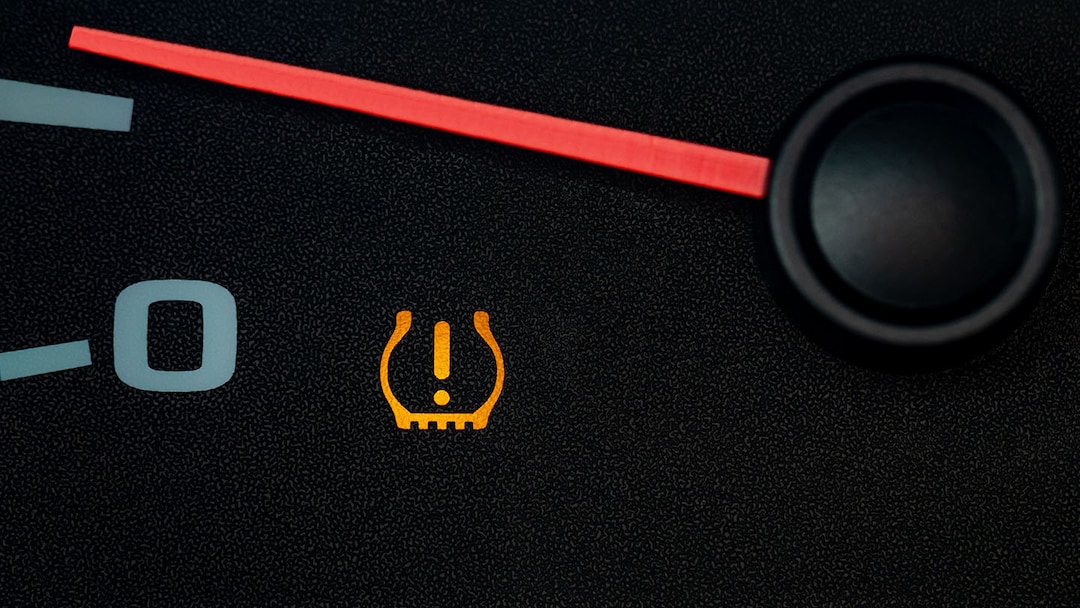The tire pressure light: What it is and how do you fix it?

Quick Insights
- The Tire Pressure Monitoring System (TPMS) light alerts drivers to significant under-inflation or over-inflation in one or more tires, which can affect vehicle handling and safety.
- Common causes of low tire pressure include temperature changes, natural air loss, leaks and impact damage.
- Regular checks and adjustments of tire pressure, as well as maintenance of the TPMS, can be helpful for optimal tire performance, safety and fuel efficiency.
Ever wondered about that little light on your dashboard that looks like a horseshoe with an exclamation point in the middle? It's more than just a decoration - it's an important part of your vehicle's safety system. Let's deflate the mystery around the tire pressure light.
Key vocabulary
Before we get into a more in-depth look at tire pressure, it can be helpful to first review some key terms:
- TPMS light: TPMS is an abbreviation for the Tire Pressure Monitoring System light, a vehicle feature that alerts the driver when the tire pressure is either too low or too high.
- PSI: PSI stands for Pounds per Square Inch and is the unit of measurement used to express tire pressure.
- Valve stem: This small tube, made of metal or rubber, allows air to enter or exit the tire. If the valve stem is damaged, it can lead to air leaks and low tire pressure.
- Impact damage: This term refers to the damage caused by hitting a curb, a pothole or debris, which can damage the tire, cause leaks and otherwise alter tire pressure.
- Tire pressure gauge: This tool is used to measure the pressure of each tire. To use it, simply attach it to the valve stem of your tire and read the resulting pressure measurement. Tire pressure gauges can be purchased at auto parts stores, online retailers, hardware stores and some gas stations.
- Tire information placard: This label provides information about the correct tire pressure and tire sizes for the vehicle. It is often located on the driver's door edge, doorpost, glove box door or inside the fuel hatch.
Now that we understand the vocabulary, let’s take a deeper dive into your car’s tire pressure.
What does the TPMS light indicate?
The TPMS light is an important vehicle feature that is designed to alert you about issues with your tire pressure. Here's what it could mean when it lights up:
- The TPMS light illuminates and stays on: This signals that one or more of your tires may be significantly under-inflated or over-inflated. This could affect the vehicle's handling and safety. If you notice this happening frequently, it might be worth checking your tire for a slow leak.
- The TPMS light turns on intermittently: This could happen when your tire pressure is borderline acceptable. For instance, cold morning temperatures might cause your tire pressure to drop slightly, triggering the light. However, as you drive and the tires heat up, the pressure may increase and the light could turn off.
- The TPMS light flashes for a minute, then stays on: This is a less common occurrence and typically suggests a malfunction within the tire pressure monitoring system itself. The issue could be with the system's computer, a faulty wire or one of the individual sensors. In this case, it's best to take your vehicle to a mechanic for a proper diagnosis.
Remember, maintaining the correct tire pressure is crucial for optimal vehicle performance and safety. So, if your TPMS light comes on, it's important to address the issue as soon as possible.
What causes low tire pressure?
- Temperature changes: One of the most common triggers for your TPMS to light up is temperature change. Significant temperature drops can cause the air inside tires to contract, leading to decreased tire pressure. Hot temperatures similarly cause the air to expand, raising tire pressure.
- Natural air loss: Tires naturally lose air over time, usually at a rate of about 1-2 (psi) per month.
- Leaks: Punctures or damage to the tire or valve stem can cause air to leak, resulting in low tire pressure. If your tires continually lose pressure even after refilling them, it could be a sign of structural damage or puncture.
- Impact damage: Hitting a curb, pothole or debris can damage a tire and alter the pressure.
How to fix low tire pressure
To fix low tire pressure, start by using a reliable tire pressure gauge to check the pressure of each tire. Compare the measured psi to the recommended psi for your tire and/or vehicle. If the pressure is low, inflate the tires to the appropriate level specified by your vehicle or tire manufacturer.
It's also important to regularly inspect your tires for any signs of damage or wear that could lead to air loss. If tire pressures continue to drop after refilling, consider visiting a professional mechanic as this could indicate a slow leak that needs repair.
Where to find your vehicle’s tire pressure info
You can find information regarding the correct tire pressure for your vehicle from several reliable sources:
- Owner’s manual: The most accurate and specific information about the recommended tire pressure for your vehicle is typically found in the owner’s manual. This manual provides details tailored to your specific model.
- Tire information placard: Information about your correct tire pressure is usually located on the edge of the driver’s door, the doorpost, glove box door or inside the fuel hatch. It not only lists the tire sizes but also the recommended tire pressures for both front and rear tires.
- Inside the fuel hatch: In some vehicles, the recommended tire pressures are posted inside the fuel hatch.
- Manufacturer’s website: Both automobile and tire manufacturers typically provide tire pressure information on their websites. Unless you replaced your car’s tires with aftermarket tires, the vehicle manufacturer is probably a more accurate resource than the tire manufacturer.
It's important to check the tire pressure regularly and adjust it according to these recommendations to ensure optimal tire performance, safety and fuel efficiency.
Is low tire pressure urgent?
While there can be more urgent issues than low tire pressure, it isn’t something you should put off fixing for long.
Driving with low tire pressure can significantly affect the vehicle's handling, increase tire wear and potentially lead to tire failure. Low tire pressure reduces fuel efficiency, costing you more money in fuel over time.
It is advisable to address low tire pressure immediately to ensure safe driving conditions and maintain your vehicle’s health.
Tips for maintaining optimal tire pressure
- Regular checks: Make it a habit to check your tire pressure monthly and before long trips or carrying extra load.
- Seasonal adjustments: Be aware that tire pressure can vary with seasonal temperature changes, requiring more frequent checks and adjustments during extreme weather.
- TPMS maintenance: Ensure that your vehicle’s TPMS is functioning correctly by having it inspected during regular vehicle maintenance.
The bottom line
The tire pressure light helps maintain the safety and efficiency of your vehicle. Understanding what triggers this light and how to respond not only keeps you safe on the road but also helps in prolonging the life of your tires and optimizing your vehicle's performance. Regular maintenance and immediate attention to tire pressure issues are key to ensuring that your vehicle remains in top condition.



